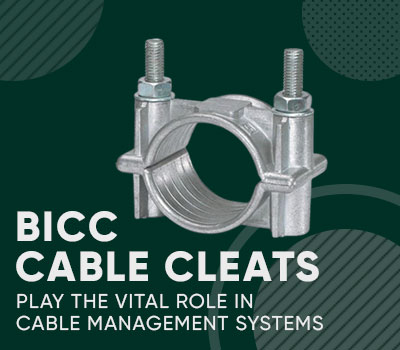Setting up of electrical cables is a time-consuming affair especially as proper installation is crucial not just to the project but also for overall safety. In the cable management system, however, one aspect that is frequently overlooked is that of cable cleats. In fact, instead of treating it like a vital aspect of the installation, it is often treated as just any other sundry item.
First Up, What Exactly is a Cable Cleat?
Cable cleats are devices that ensure that cables are supported and that the load exerted on them by their own weight, is reduced. They are also designed to contain the cables under fault conditions. In the absence of cable cleats there isn’t just costly damage to the cable management system, it can also lead to loss of life.
It is important to know that damage to the cables under fault conditions generally occurs within the first quarter cycle of the fault. A typical circuit breaker, on the other hand, is known to interrupt the fault after three cycles. Whilst this may help protect the equipment, the cables may have already been damaged by this time and would need to be replaced. The replacement of cables of course comes at a high price especially if you include the downtime that the system is subject to, in the interim.
If one was to, therefore, look at the broad advantages of using a cable cleat, they include:
- Help reduce cable load
- Improve support of conductors and cables
- Restrict mechanical load on cable terminals
- Provide security in case of short-circuit
- Offer resistance to electromechanical forces
- Ensure overall safety
It is, therefore, imperative that cable cleats with the right specifications be employed for each project, basis the bespoke requirements, as different cable cleats are designed to withstand different forces. It is important also to keep in mind that while cable cleats have different short circuit withstand levels, they are only valid for a cable diameter equal to or greater than the diameter used in the test.
While engineers may be fully cognizant of this fact, when the specification reaches the buyer, oftentimes price becomes the only parameter of selection. While ensuring the correct cable cleat may seem to escalate the costs initially, if you look at the costs in a long-term perspective, the costs are more than amortized. This is true since the cost involved in terms of material, manpower and time in replacing an entire cable management system is likely to surpass the initial cost escalation several times. This, of course, is without taking into account the irreplaceable loss of life that could also accrue on account of a wrong selection.
In case of new installations, therefore, it is important to determine the type and strength of cable cleat required at the design stage itself. Some of the aspects that go into the choice of the right cable cleat include checking for:
- Cable diameter
- Performance
- Cable Format
- Design, which in turn involves looking at aspects such as mechanical load, short circuit rating, cable configuration, cable run length, expansion and more.
As a widely trusted cable cleats manufacturer, Cable Cleats offer a range of viable options to meet various requirements. We also provide bespoke products that are customized to your unique needs. Here is a quick look at some of the Cable Cleats play a vital role in Cable Management Systems:
- Cable Cleats are offered in aluminum as well as in non-metallic types that work for different installation environments.
- When it comes to highly polluted areas, BICC’s Epoxy coated cleats are known to stand the test of time.
- In addition, BICC also offers two-bold aluminum cable cleats as well as trefoil aluminum cleats that work well for a range of applications.
- Our tamper proof cable cleats go a long way in minimizing copper cable theft
- The Stainless Steel Cable Cleats are especially designed for low, medium and high voltage cables
- Two bolt cable cleats are best suited for horizontal and vertically routed HV cables.
- The single way cable cleats have excellent resistance to harmful climate
At BICC Components Limited (BICC) we are committed to provide not just a wide range of industrial cable glands, cable cleats, connectors and associate accessories, importantly our strength lies in our relentless pursuit of quality and a detailed understanding of bespoke consumer requirements.
 SUBSCRIBE TO OUR BLOG
SUBSCRIBE TO OUR BLOG
